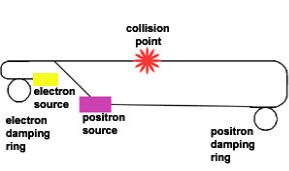

Monday - June 12, 2006
SLAC Today is
available online at:
http://today.slac.stanford.edu
In this issue:
Designing a Particle Superhighway
Dorfan Today: Felicitations au LAL
Beta Test the New SLAC Travel System
 |
 |
|
Monday - June 12, 2006 |

In the ILC, both electrons and positrons will be created on one side of the accelerator; the electrons will be directly injected into a damping ring, while the positrons will have to travel the length of the accelerator before being injected into their own damping ring. Designing a Particle SuperhighwayIn the International Linear Collider (ILC), electrons and positrons will travel in the fast lane, eventually smashing into each other with unprecedented energies. Yet before the particles can begin their journey down the linear accelerator, they need to make it to their respective starting lines, 30 kilometers apart. This task is more difficult than one might expect. Due to technical constraints, both the electrons and positrons will be created on one end of the machine. The electrons will be fed into the nearby damping ring and then into the linac, but the newly created positrons must travel all the way down to the other end of the accelerator before turning around and accelerating back toward the collision point. Precisely guiding this beam over such a long distance is a challenge. Read more... |
||||||||||||||||||||||||||
|
|
||||||||||||||||||||||||||
 Félicitations au LALAccelerator-based science is possibly the most collaborative of all the major fields of "big" science. Competition to be the "discoverer" rather than the "validator" is both healthy and a key ingredient for producing outstanding science. Notwithstanding this often very intense competition, laboratories, detector collaborations and individuals openly share detailed information on new concepts, novel ideas their development and optimization across the full spectrum of research tools. So it is for several SLAC programs. While BaBar and Belle compete to discover new physics before the other, PEP-II and KEKB help each other on a continuous basis, sharing what each learns about machine performance or helping each other to maximize future improvements or fix known problems. In addition, our highly experienced SSRL staff is often involved in helping with the design, implementation or improvements of other synchrotron light sources worldwide, all of which compete for very similar scientific "prizes." Read more... |
Beta Test the New
|
Events (see all | submit)
Access (see all)
Announcements
|
||||||||||||||||||||||||
| | ||||||||||||||||||||||||||
What's Cookin' at the Linear Cafe (see weekly menu)
|
||||||||||||||||||||||||||
|
|
||||||||||||||||||||||||||
 <%
Response.AddHeader "Last-modified", getArticleDate()
'Response.AddHeader "Last-modified","Mon, 01 Sep 1997 01:03:33 GMT"
'Monday, December 06, 2010
%>
<%
Response.AddHeader "Last-modified", getArticleDate()
'Response.AddHeader "Last-modified","Mon, 01 Sep 1997 01:03:33 GMT"
'Monday, December 06, 2010
%>View online at http://today.slac.stanford.edu/. |
||||||||||||||||||||||||||